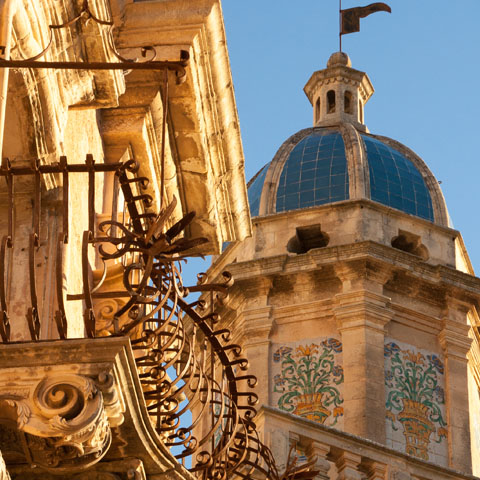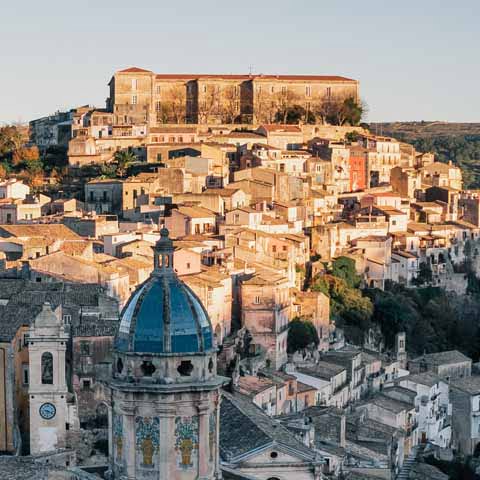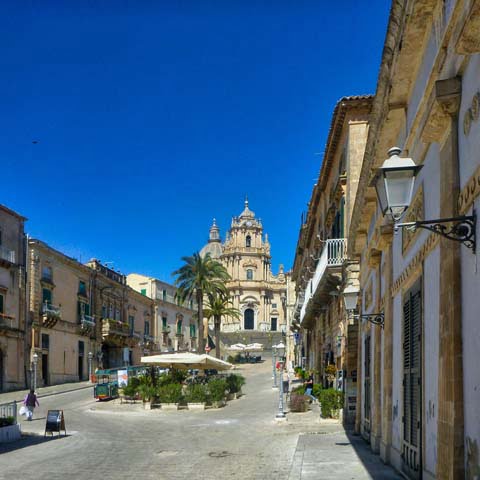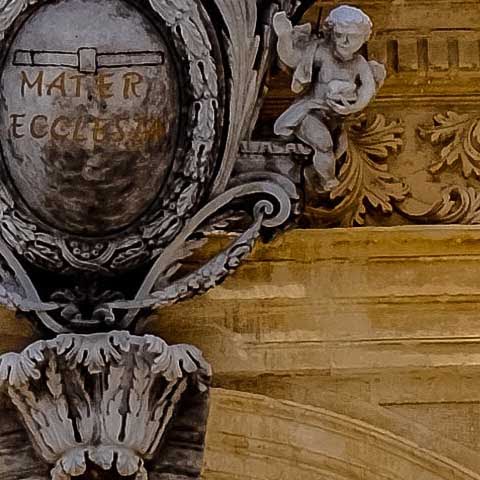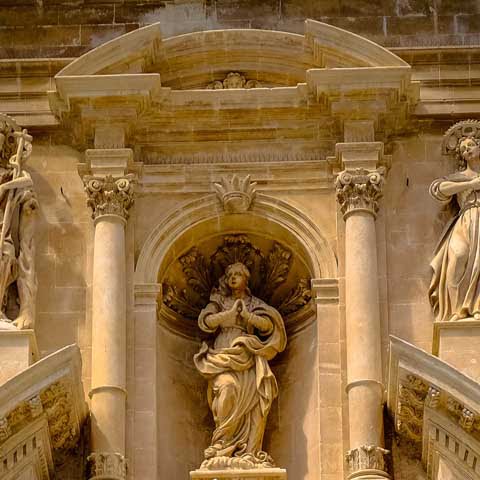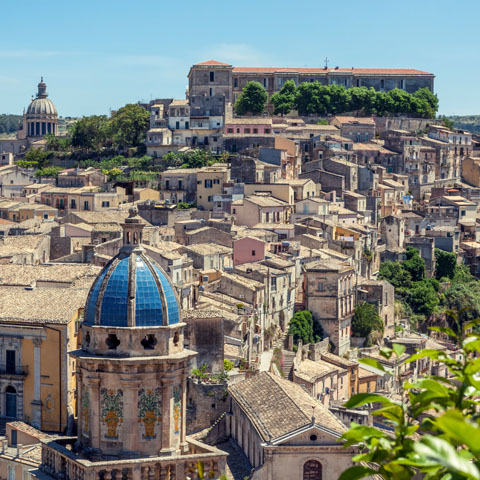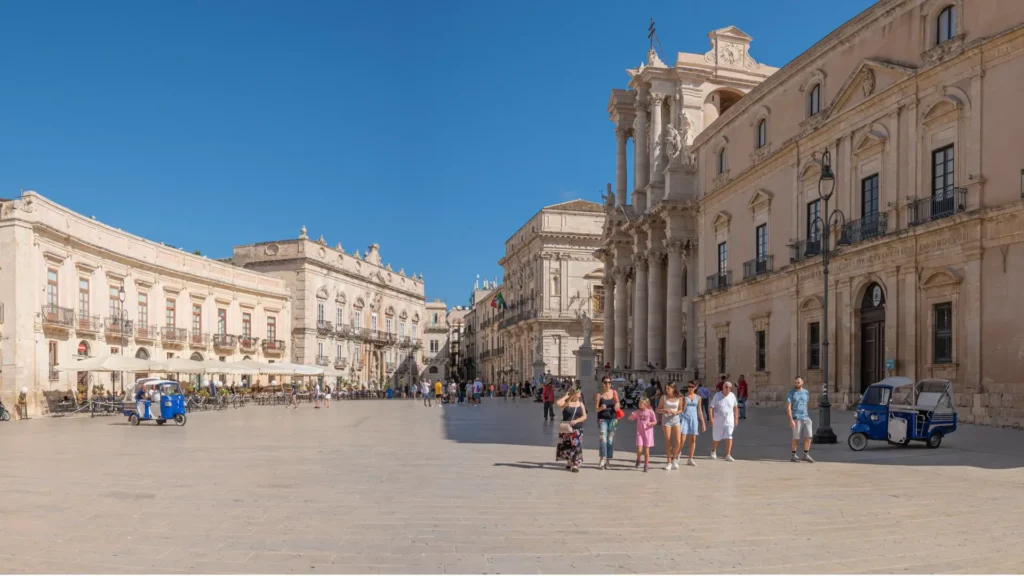Ragusa is a city rooted in both the past and modern times. This is evident not only in the city’s two distinct areas – the upper and lower parts of Ragusa – but also in the city’s culture. From strolling the streets and marveling at the Baroque architecture that fills the town to taking in modern day street art, a visit to Ragusa promises a bit of the old and the new. Whether looking at traditional sightseeing locales or taking part in local festivals and events, the culture of Ragusa is reflective of the city’s traditions as well as its modern advancements.
ART IN RAGUSA
Excellent examples of art can be admired throughout any one of Ragusa’s many churches. In the Cathedral of St. George, travelers will find some of the city’s oldest and most valuable artwork including a cycle of frescoes depicting the final events of the life of St. George. The Cathedral’s sacristy is home to several priceless treasures including busts representing saints, intricate gold chalices, and reliquaries. The grand pipe organ located in the church is also a work of art in and of itself consisting of more than 3,300 pipes and dating back to the late nineteenth century.
The Cathedral of St. John the Baptist is renowned for its Baroque architecture as well as its sculptures and an enormous canvas depicting the crucifixion of Jesus. The façade of the grand church features decorated columns and statues of Mary, St. John the Baptist, and St. John the Evangelist.
Additionally, be sure to stop by the Museo del Duomo (The Cathedral Museum) in Ragusa Ibla. This small but fascinating museum is home to several sculptures and other works of art that survived the 1693 earthquake, as well as architectural drawings.
From statues to paintings to other unique art pieces, Ragusa’s famous structures are brimming with fascinating art to take in.
Moving on to the city’s new traditions, one of the most important art events in Ragusa is FestiWall – a week-long celebration of street art. During the festival, artists create unique and interesting street murals. The town transforms into an open-air gallery of sorts, showcasing the artistic talent and deep-rooted passion of the city.
While walking the streets, travelers can gaze upon a variety of murals painted all over the city walls. Some of the most notable public art pieces include works by Daniel Eime, Francesco Camillo Giorgino, and Pixel Pancho.
ARCHITECTURE IN RAGUSA
In 2002, the Baroque buildings of the historical city center of Ragusa, together with seven other cities in Sicily’s Val di Noto, were declared a UNESCO World Heritage Site. Following the 1693 earthquake that devastated the area and killed thousands of citizens, a group of famous architects, together with local sculptors, set out to rebuild the cities. The result was the birth of a distinct architectural style referred to as the Baroque of the Val di Noto.
The new buildings were constructed using local stones and featured stylistic elements prevalent at the time including columns, capitals, and statues. The reconstruction efforts in Ragusa began just as the Baroque period entered its final phase in the rest of Europe. Therefore, the remarkable Baroque structures in Ragusa and the rest of the Val di Noto embody the final masterpieces of the Baroque style, and they are also renowned for this reason.
The best example of architecture from this period is Ragusa Ibla’s Cathedral of St. George, which was constructed in the late 1700s and features massive columns and ornate statues as well as a characteristic Neoclassical dome. In fact, the vast majority of Ragusa’s Baroque architecture is found in Ragusa Ibla, with over fifty churches and historical buildings constructed in this style in Ragusa Ibla alone. One of the exceptions would be the Baroque Cathedral of St. John the Baptist in Ragusa Superiore, which was built in the early eighteenth century and features a very ornate exterior with three portals.
On the narrow street which connects upper and lower Ragusa, one will find Santa Maria delle Scale, or “Saint Mary of the Steps.” Like the city itself, the church has two distinct features – a side that is traditionally Gothic in style and the other which was rebuilt after the earthquake and features the Baroque architecture that Ragusa is known for.
In nearly every aerial photo taken of Ragusa’s skyline, a bright blue dome will stand out against the grey and cream-colored buildings. This is the bell tower of the Church of Santa Maria dell’Itria. As you get closer to the bell tower, you will notice that the eight panels below the dome are decorated with beautiful floral designs. The church itself was founded in the fourteenth century and suffered only partial damage during the 1693 earthquake. Eventually, the church was updated in the eighteenth century with a Baroque façade.
A little less than ten miles outside of the city of Ragusa, travelers will find a unique building that is a departure from the characteristic Baroque architecture found in the old town of Ragusa Ibla. Known as the Donnafugata Castle, this striking fortress has origins in the fourteenth century, yet its most distinctive elements, which are mainly attributable to the Neoclassic and Neogothic styles, were fruits of the nineteenth century. In fact, the intricate loggia and arched windows are more reminiscent of Venice than of southern Sicily.
Other notable architectural structures to view in Ragusa are the Church of the Souls of Purgatory, the Church of San Giuseppe, the Church of Sant’Antonino, and many more.
LITERATURE
Writers and poets have celebrated Ragusa for centuries. From the architecture to the food, it’s easy to see why this city is worthy of being documented in plays, novels, and poems.
In celebration of Ragusa’s one-of-a-kind Sicilian cuisine, Shakespeare notably praised the area’s delicious Hyblaean honey and Cato wrote in praise of Ragusa’s cuisine, specifically cassateddi – baked pastries filled with ricotta and cinnamon.
The city of Ragusa and its surroundings, with a unique layout and history, have also influenced books. The Castle of Donnafugata, located in a hamlet of Ragusa, may have served as inspiration for author Giuseppe Tomasi di Lampedusa’s novel entitled Il Gattopardo (The Leopard), which is set in a fictional town named Donnafugata. The work is cited as one of the most important pieces of modern Italian literature. In addition, the Castle of Donnafugata was used as a setting in the Commissario Montalbano book series. Fans of literature will enjoy A Tutto Volume, an amazing literary festival held in Ragusa’s historic district. During the three-day event, Italian writers are featured and events such as readings and talks are held.
Finally, a key figure of Italian poetry, Salvatore Quasimodo, was born just ten miles south of Ragusa in the stunning city of Modica. Quasimodo, who also translated Greek and Roman works, was renowned for his use of hermetic language, and his poems frequently centered on his native Sicily, as well as death and religion. The poet was awarded the Nobel Prize for Literature in 1959.
MUSIC
Every year, Ragusa holds events and festivals that highlight music. During the summertime, the Addio all’estate, or “Farewell to Summer” event occurs. In addition to parades and festivals, there are a variety of live performances, including classical music.
Another wonderful musical event is the Ibla Grand Prize. This is an international music competition and festival that lasts nine days. It features free concerts of music from all genres, including jazz, classical, and contemporary music, all throughout the city.
FILM
Ragusa has been the filming location for Il Commissario Montalbano, a popular Italian detective series based on the novels by Andrea Camilleri. Areas like the historic city center’s piazze and the Cathedral of St. George have been featured as well as the Castle of Donnafugata outside of the city. Furthermore, the Castle of Donnafugata was also a setting for part of the 1963 film Il Gattopardo, directed by Luchino Visconti, and Matteo Garrone’s 2015 film Il racconto dei racconti – Tale of Tales.
ARCHAEOLOGY
To experience the history of the city, visit the Archeological Museum. It features unique archeological finds from early settlements such as sculptures, artifacts, and pottery from prehistoric times to the Greek and Roman times.
Not far outside of Ragusa are two archeological sites worth visiting for fans of science and history. The ruins of the ancient cities of Kamarina and Kaukana remain, giving travelers insight into what life was like in ancient Sicily.
Travel Guides
The Sicily Region of Italy
The Cities of Sicily, Italy
